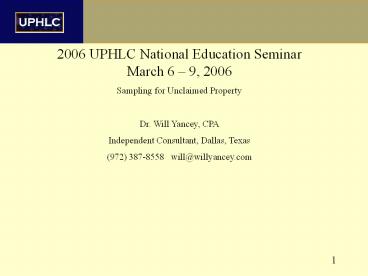2006 UPHLC National Education Seminar March 6 PowerPoint PPT Presentation
Title: 2006 UPHLC National Education Seminar March 6
1
2006 UPHLC National Education Seminar March 6
9, 2006 Sampling for Unclaimed Property Dr. Will
Yancey, CPA Independent Consultant, Dallas,
Texas (972) 387-8558 will_at_willyancey.com
2
Sampling for internal purposes
- Sampling to analyze UP exposure
- Exploratory sampling to identify internal control
weaknesses. - Plan what further work is needed.
- Estimate UP reserve for financial statements.
3
Sampling for UP audit and VDAs
If periods where no transaction-level
documentation can be retrieved, estimate a
UP-to-revenue ratio from available records and
project onto revenue for period without available
records. Sampling usually not allowed where can
be identified for true owners. If high-volume of
transactions below the threshold for reporting
owner name, state UP auditor might allow sampling.
4
Triage the data download
EXCLUDE areas of extremely low error rate,
dormancy not expired, items with very low
. DETAIL (EXAMINE ALL) items with high
amounts, areas of extremely high error rate,
specific legal issues. SAMPLE items not
Excluded or Detailed
5
Sampling Plan
- Trade-offs in sample size
- Costly to increase sample size
- Benefit of larger sample size is more accuracy.
- Some costs and benefits are readily quantified,
and some are not. - What determines sample size?
6
Parable of Footballs and Fish
1. You are asked to determine the weight of 1,000
footballs. You know they are identical in
weight. You can weigh only one ball at a time.
How many must you weigh? 2. You are asked to
determine the weight of 1,000 different fish
taken from a lake. They are highly variable in
weight. You can weigh only one fish at a time.
How many must you weigh?
7
Variability drives sample size
The variability in the population drives sample
size. Reducing variability within a group reduces
required sample size. Suppose we can group and
count the fish before we weigh them. What can we
do so that we do not need to weigh so many?
8
Grouping data for UP sampling
- What attributes are most likely to change the
frequency of UP? - Customer type (commercial, residential)
- Employee type (hourly, salaried)
- Length of time outstanding
- Accounting system change
- Others?
9
Stratifying Within a Group
Most accounting line item data files have lots of
small transactions and relatively few large
items. Stratified Random Sampling example Above
1,000 detail exam 100 to 1,000 sample
stratum 10 to 100 sample stratum 1 to 10
sample stratum 0 to 1 exclude
10
Minimum sample size per stratum
- No universally accepted policy on sample size.
- A simple rule for determining sample size
- What is the minimum number of errors required for
projection? - How low an error rate do you want to detect?
- Sample size per stratum Minimum number of
errors Minimum detectable error rate - 3 .01 300
- 3 .05 60
- 3 .10 30
11
Sampling Risk
Sampling risk is the chance that the result from
a sample differs from the result from examining
every item in a population. Every sample has some
sampling risk. A well-designed sample has less
sampling risk. Sampling risk would be eliminated
if every item in the population were examined.
12
Statistical Sampling
- In statistical sampling, sampling risk is
estimated quantitatively based on statistical
theory. - Examples
- 95 confidence the population total is in the
range 160,000 to 240,000 ( 200,000 20) - 90 confidence the population total is in the
range 180,000 to 220,000 ( 200,000 10) - In statistical sampling every item in the
population has some known positive probability of
selection. That probability may differ between
strata.
13
Nonstatistical sampling
Nonstatistical sampling does not quantify
sampling risk based on statistical theory. The
sampling risk and acceptability of the sample
depend on the auditors judgment. If a stratified
random sample is taken, but no statistical
quantification of sampling risk is presented,
then it is nonstatistical sampling.
14
Nonsampling Risk
Nonsampling risk includes every other risk that
the sample results are not representative. Measure
ment error, such as the auditor incorrectly
interprets facts or law. Selection bias, such as
selecting too many items from beginning or end of
audit period. Projection bias, such as the period
being projected onto is not similar to the period
that was sampled.
15
Avoiding Sampling Disputes
- Invest time in analyzing the population.
- Take a preliminary sample to verify availability
of records. - Discuss the sampling plan with all parties and
make changes. - Document sample selection method.
- Ask a sampling expert to review the method.
16
References
willyancey.com/statistics.htm willyancey.com/sampl
ing-financial.htm willyancey.com/unclaimed.htm Yan
cey, Statistical Sampling in Sales and Use Tax
Audits, onlinestore.cch.com Guy et al,
Practitioner's Guide to Audit Sampling, (Wiley,
1998).
17
Questions

